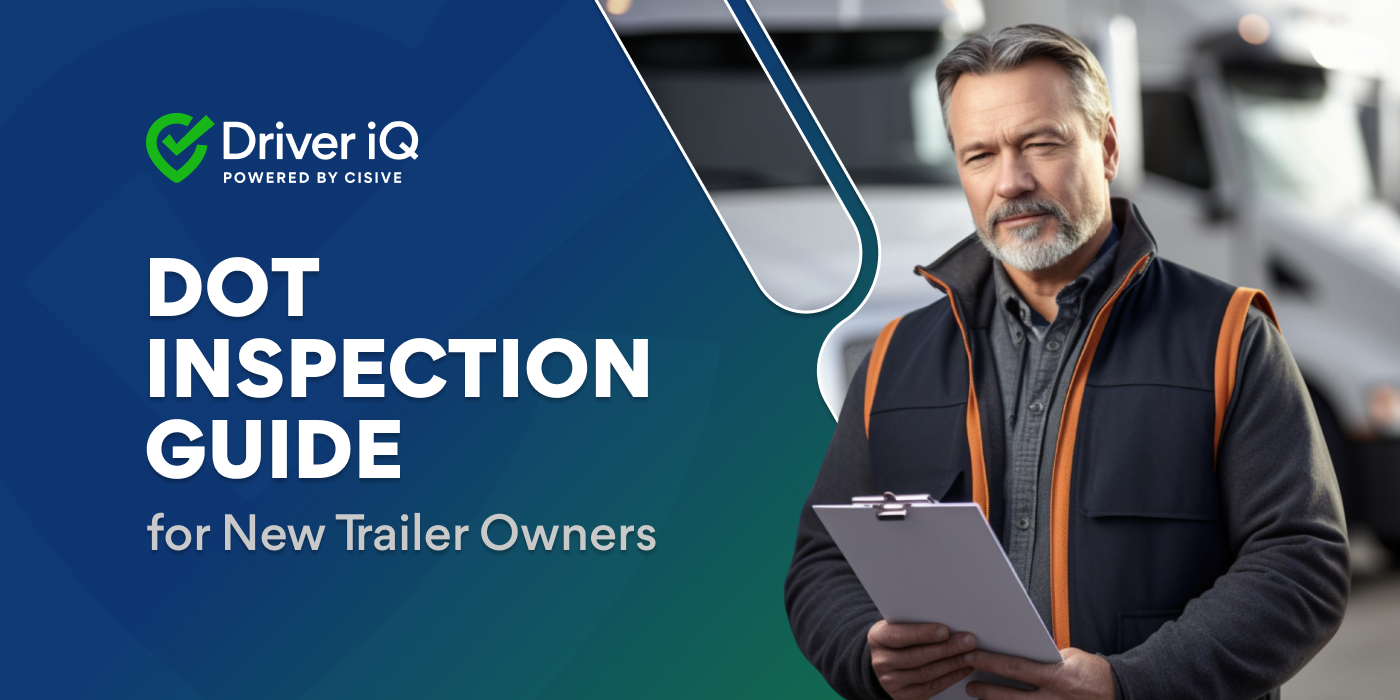

Picture this: You hired a driver with a clean driving history, and he’s worked for you for over a...

Owning and operating a new trailer can be an exciting experience. However, it’s important to understand all DOT requirements before you head out on the road, including how DOT inspections work.
Failure to pass a DOT safety inspection could result in various fines and penalties, which could be quite costly for your business.
Depending on the severity of the violation, it could even put your trailer or driver out of service. This means your truck stays put until you make the necessary corrections.
This could ultimately impact the success of your business. Rather than waiting until it’s too late, there are several things you should know about DOT inspections, including:
DOT (Department of Transportation) inspections can be a stressful process, especially if it’s your first time. You can minimize this stress by understanding how DOT inspections work and how to prepare for one.
This guide provides details about the various types of DOT inspections and explains why these safety checks are so important. It also provides tips on how to prepare yourself and your trailer for these types of inspections.
Key Takeaways:
|
A Dot inspection is a safety check conducted on commercial trucks and trailers weighing over 10,000 pounds.
Qualified inspectors from the Department of Transportation or state police officers typically conduct these inspections. These safety checks ensure that large commercial vehicles and truck drivers are safe to ride on the roadway and in compliance with all state and federal regulations.
According to the Federal Motor Carrier Safety Administration (FMCSA), all commercial trucks and trailers over 10,000 pounds must undergo a DOT inspection at least once a year. Some states may also have additional DOT inspection regulations that truckers must follow.
There are eight types of DOT inspections officials conduct. The type of inspection conducted depends on the reason for the safety check.
Below is a look at the eight different types of DOT inspections and their purposes.
The Level 1 inspections are the most comprehensive of the eight types. This 37-step tractor-trailer inspection can take anywhere from 30 to 60 minutes or longer.
It includes a comprehensive inspection of the truck and trailer, including an examination under your vehicle. The inspector will physically climb under your truck as part of the inspection.
The inspector or officer makes sure all safety elements, including brakes, tires, and lights, are in good working order and meet regulatory standards. They will also check all driver documentation, including driver’s license, registration, insurance, and ELD book.
Recommended Reading: Level 1 Inspection Checklist
The Level 2 DOT inspection is one of the most common safety checks conducted.
While this inspection level is similar to a Level 1 check, the inspector or officer does not get under the vehicle. Instead, they walk around the entire truck and trailer and only check safety items they can see without physically getting under the vehicle.
Just as with a Level 1 inspection, drivers must show all required documentation, including driver’s license, logbook, and registration. As long as there are no issues and you have all your paperwork in order, a Level 2 DOT inspection should take about 30 minutes to complete.
While an inspector or officer can conduct Level 3 DOT inspections for various reasons, the most common cause is traffic violations, such as speeding or using a phone while driving. Typically, these inspections are conducted on the side of the road or at the nearest location where the truck and trailer can pull over safely.
As the name suggests, the inspector only checks the driver’s records, including driver’s license, carrier identification and status, hours of service, and vehicle inspection reports. While these inspections typically only take about 15 to 20 minutes to complete, the inspector can upgrade the stop to a Level 1 or Level 2 Inspection if they notice extensive issues with the vehicle.
Inspectors and officers conduct special inspections as part of an ongoing study to track specific features on your vehicle or to note driving trends. This is a one-time inspection that the Commercial Vehicle Safety Alliance or the Federal Motor Carrier Safety Administration uses to gather more information about a specific issue.
A Level 4 inspection could involve details about your driving credentials or vehicle components. Because inspectors are only checking for just one specific feature, it usually only takes a few minutes to complete.
Truck drivers don’t need to be present when inspectors or officers conduct Level 5 inspections. Typically, these examinations are done after an accident where the driver must go to the hospital or after a driver is arrested and taken to the police station.
Level 5 inspections are similar to Level 1 checks, where inspectors and police officers can inspect the entire truck, including physically crawling under the truck and trailer. However, they don’t check any driver documents.
Recommended Reading: When Is FMCSA Post-Accident Drug Testing Required
Level 6 inspections are only conducted on certain trucks and trailers transporting radioactive materials. Inspectors examine all driver information, including carrier identification and status reports, logbooks, and driver’s licenses.
These examinations are conducted before the driver departs.
Once the driver and vehicle pass the Level 6 inspection, a special sticker, noting radioactive material, is attached to the vehicle.
A Level 7 inspection is for commercial vehicles that aren’t required to undergo Level 1 to Level 6 inspections, such as school buses, limousines, shuttle services, and taxis. Each jurisdiction determines who can conduct these types of inspections and dictates training standards.
Level 8 inspections are conducted electronically without the need for the driver to pull over. Only certain types of vehicles are eligible for this type of inspection, and the trucks must be equipped with the required tracking devices.
This safety check allows inspectors or officers to examine the driver and vehicle information electronically, such as records of duty status, driver’s license, and operating authority.
The Department of Transportation conducts tractor-trailer inspections for a number of reasons.
Safety is the first and foremost reason for DOT inspections.
Tractor-trailers are a key component of the U.S. economy. Due to their size and weight, these large trucks can also be dangerous if they malfunction.
Conducting regular safety checks can prevent issues from happening on the road. This helps keep all drivers safe.
Truck drivers and trucking companies must comply with state and federal regulations. States use DOT safety checks to ensure all drivers and companies remain in compliance with these rules.
A benefit of DOT inspections is that they can help keep your truck in good working condition. A standard DOT safety check could reveal a minor issue with your truck and give you time to fix it before it becomes a more costly problem.
When preparing for a DOT inspection at any level, it’s important to know what to look for.
Below is a look at various items you should frequently check. This DOT tractor inspection checklist is not necessarily all-encompassing, but it’s a good starting point.
Start your inspection by making sure all your required documents are in place and easily accessible. This includes:
The examiners can assess all components of your brake system, including:
Before you head out on the road, make sure all your reflectors are securely in place and that all your lights are in good working condition.
During a DOT inspection, the examiner will walk around the truck and trailer to make sure all your lights are working properly, including:
Having just one light malfunctioning could put your truck out of commission until it’s fixed.
During a DOT inspection, the examiner looks for wear and tear throughout your steering and suspension systems. This includes a close examination of various parts, such as:
Inspectors will inspect every tire on your truck and trailer. They are looking for excessive wear and tear and that your tires are securely in place.
A DOT inspection includes an examination of various components, including:
Cargo securement is a key component of DOT tractor inspections. It’s vital that your cargo is securely in place.
The inspector will check your tie-downs by making sure you have enough to keep your cargo secure and that each tie-down is secure.
All tie-downs and holders in use must be in good condition. There should be no worn edges, cracks, chips, or other damage.
The main thing to remember is that your cargo should not shift during transport.
Recommended Reading: Best DOT Compliance Services
Once the DOT inspection is complete, the examiner will explain their findings to you. If the inspector finds no violations and it’s a Level 1 DOT inspection, you’ll receive a CVSA sticker to attach to your vehicle, along with a Driver Vehicle Examination Report (DVER).
If there are no violations and it’s a Lever 2-8 inspection, you’ll only receive a DVER report. This report includes details of the inspection and should be kept with your Driver Qualification Files.
If, on the other hand, you have one or more violations, several things could happen.
To ensure you don’t face any violations on your next DOT inspection, it’s important to conduct frequent safety checks. This step can alert you to issues before you’re stopped for a safety check.
You also want to make sure you stay on top of your paperwork, keep all your documents orderly, and always know where to find any mandatory reports.
Another important step to make sure you pass your next DOT inspection is to hire experienced truckers with a history of compliance.
Driver iQ can help you with this process by conducting extensive background checks on prospective candidates. These background reports can provide the details you need to make sound hiring decisions.
Speak to one of our experts to learn more about our background-checking services.
Author: Michael Kapuschinsky
Bio: Product Manager with more than a decade of experience in the transportation industry.
Let's Connect on LinkedIn
Picture this: You hired a driver with a clean driving history, and he’s worked for you for over a...

Recently, Carlo Solórzano, Senior Director of Sales & Business Development at Driver iQ, joined the...

Anyone in the trucking or transportation industry knows how vital maintaining DOT compliance is....